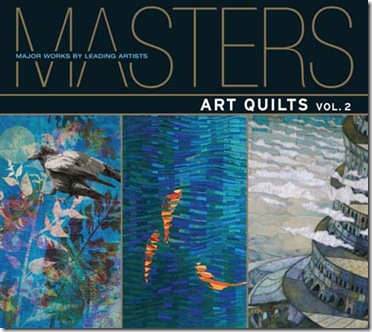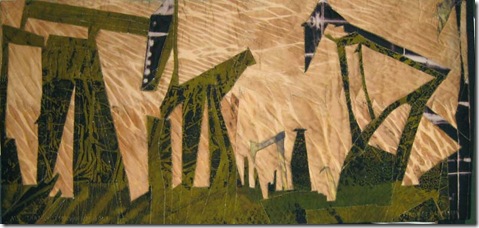Quilters often say they wish that “they” (critics, museums, galleries, collectors, the public) would recognize quilts as a mainstream art medium. Other media, for example photography, have developed to the extent that most museums now include photographs in their collections and display them regularly. So, why not quilts? At least part of the answer is that quilts have not developed from their early beginnings in anything like the way that other media have.
The possibility of printing very large color photographs has lead to major shows of photographs in museums and galleries but these photographs are nothing like traditional photographs. They are often artfully staged then super-hyped by computer manipulation and finally displayed with back lighting that makes them very stunning and dramatic. I’d love to see a large transparent quilt displayed like this! but I haven’t.
Traditional paintings were made from paint upon a rectangular stretched canvas. Traditional quilts were composed from three layers: pieced fabric patches assembled into well known geometric patterns, batting (which might be cotton, or an old blanket or even newspapers or corn husks), and then a backing fabric. Contemporary paintings, however, might be made quite unconventionally - collages of plants or pills for example, painting on mattresses (and 0n quilts!), wall reliefs composed from tiles and foam, rubber and old tires, gold leaf and scraps of paper. and these seem to be the kinds of works you see in current museum shows. You don’t see conventional paintings – however skillfully made. And it’s rare that any quilter has stretched the medium as far as this. Kyung Ae Cho did - with her wonderful slices of wood piece that was in a Quilt National some years ago, but I notice that she has now moved out of the quilt world and has been totally accepted by the fine art world.
Contemporary art is rich, diverse, and unpredictable. While painting, drawing, sculpture, photography and crafts are still popular, new media are more likely to be seen in contemporary art shows: film, video, audio, installation, performance, text, computers. And media are frequently mixed. It’s hot to use an “old” medium in a new way: paintings that are pixilated, drawing with chocolate. But how many quilts have you seen made from chocolate? (though it’s a grand idea!).
Contemporary art is in flux. New technologies make so many things possible, and also knowledge of art from different countries is mixed in with local art; there’s a significant amount of cross fertilization.
But I’m afraid, and correct me if I’m wrong(!), we don’t see these kinds of things in quilts. Quilters tend to stick very much to making quilts the way they were always made. There’s nothing wrong in this, but that’s one reason why the contemporary fine art world is not very interested. They’re not so interested in paintings made the traditional way either.
Current culture is used as a basis for art and diverse and rapid changes in what is available on the internet and seen on the street makes for lightening shifts. A few years ago quilts made from drug bags were displayed in New York galleries, but I didn’t see them pictured in any quilt magazine. There are but a few quilt artists stretching to use the detritus of modern life as their material for quilts: Pat Kroth has worked with discarded scraps of paper and fabric, for example.
Another difference I notice between “art quilts” and contemporary art is in content/no content. There have been times in the 20th century when there was more of an emphasis on form than content in the art world and artists who were preoccupied with formal matters such as the properties of a specific medium or the role of color or composition. But the contemporary belief is that such a formal approach doesn’t allow one to interpret art that expresses the artist’s inner vision, or art that refers to the world at large. In mainstream art, it is evident that artists are focused on meaningful content. They are motivated by a range of ideas much broader than their own personal emotions or their need to display a mastery of media and techniques. Some of the issues they have addressed: politics, social issues, science and technology, media, popular culture, literature, man made environments, the flow of ideas generally. There are a few quilters who are, thank goodness (!) beginning to address some of these topics: Shawn Quinlan, Kristen La Flamme and Wendy Huhn come to mind (though I notice that several of these folk don’t use the Q word!), but, again, not many.
Are the themes in contemporary quilts those we see in contemporary art? For the most part I find that quilts tend to be less personal and less political and many of them are ‘art for art’s sake’. I don’t think this is either good or bad, but it does explain why the few art critics that are left (as opposed to a huge proliferation in political commentators!) aren’t much interested in what’s going on in the quilt world. As an aside, wouldn’t it be wonderful if all those gasbag hot air political chat shows were actually about art??!! Can you imagine Chris Matthews arguing at full voice about the merits of Nancy Crow versus Ruth McDowell? Or the validity of simply printing digital photographs onto cloth because it can be done, or the meaningfulness of layering random surface designs one on top of another?
Are you ready for quilts that incorporate elephant dung? (Chris Ofili) Do you want to enclose quilts in tanks of urine? (Andres Serrano). These are some of the ideas that have gained attention in the art world. I think that the answers to questions as to why art critics arn’t interested in quilts are evident in both formal and content areas: quilters don’t really want to stretch the medium to uncomfortable (if not breaking) lengths, nor do many of them want to address some of the contemporary issues evident in main stream art. As I said before, neither good nor bad, but, rather, why!
And, if you have been, thanks for reading…now for a nice cuppa tea…then to go and start filling the tank…..
Elizabeth



















